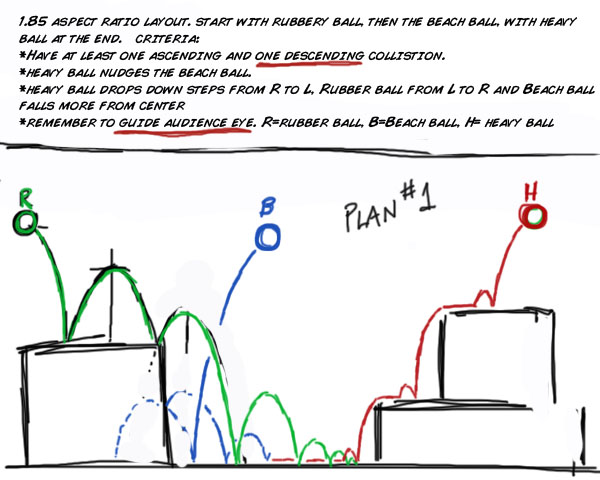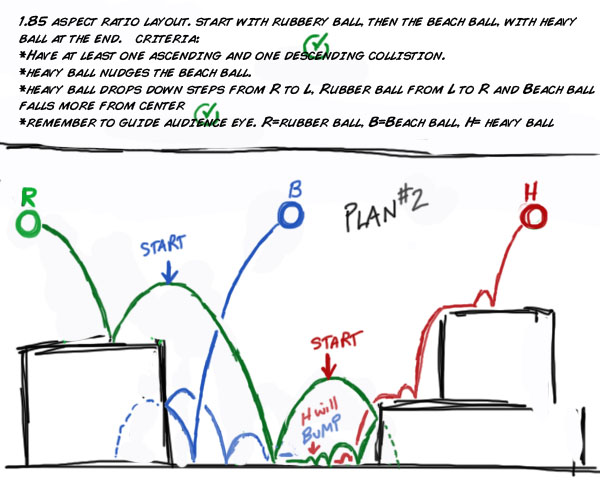Physics of Bouncing Balls. (BB)
Using the rig provided, animate 3 Balls of equal size but different properties: a springy rubber ball, a bowling ball and a very light beach ball or balloon. Play-blast from an orthographic side view so that all the balls can be clearly seen. Look for opportunities to have them bounce from different heights and deflect against different surface angles. The balls do not need to interact with each other and they do not need to come to a stop by the end of the scene. Featured principles: Timing, Arcs, Slow In/Out, and Squash/Stretch. The scene must be exactly 6 sec. long (@24fps=144fr, @30fps=180fr)
What I'll be grading on this assignment:
- Do you meet all of the assignment requirements?
- Do the bouncing balls consistently convey their individual properties?
- Are the arcs of the bounces parabolas with the apex at the proper location?
- Does the Squash and Stretch follow the tangent of travel of the ball?
- Are you effectively using the principles of Timing, Ease In/Out, Arcs, and Squash & Stretch?
Hand-in file parameters:
eg. Latour_David_BB.mov
- Movie file type must be either .MOV or .MP4
- either H.264 or MPEG4 compression
- 1920 x 1080 resolution
- File size must be <25 MB
- No .zip or .rar files please
- File must be named as follows:
eg. Latour_David_BB.mov
Part 1 - Timing, Arcs and Ease In/Out
We've talked about the relationship between distance, speed and time. Because these balls are the same size, we can only distinguish their different material properties with timing and ease in/out. Squash and stretch will also play a role, in the next module.
 |
| At the heart of timing: if you want to change speed, you must change distance and/or time. |
First (as always) we start with planning. A few quick and simple drawings to show your environment that you want to use, with some lines showing the path each ball with take. Be sure to account for any potential interactions with the environment or the other balls in the scene. The important notion here is to plan in a way that allows you to make mistakes quickly, so that we can get the bad ideas out of the way. Work out the choreography so that you have an idea you're happy with. Make note of the order that things happen in (which may require a few sketches.) Here's and example of a simple plan for this assignment. I've written a few notes and reminders for myself when I get into the animation.
*IMPORTANT* When you start this assignment, don't just copy my plan and reproduce the same animation: you must come up with a unique plan of your own. Otherwise your work is just plagiarism.
Here's the first pass with just the arcs and timing worked out. Each ball should have a distinctly different sense of mass and material. Be ready to show this much progress for next class
--------------------------------------------------------------------------------------------------------------------------
Part 2 - Refine Your Work then Add Squash and Stretch
After review in class, you should have a better idea where you can improve on your work.
Some Common Errors to Watch For:
- Hide controllers when play-blasting.
- Arcs are asymmetric/not a smooth parabola.
- Timing issue, accelerating or decelerating at wrong time.
- Timing issue, moving too fast.
- Timing issue, moving too slow.
- Not enough Ease In/Out.
- Weight/physical properties inconstant.
- Not enough acceleration at bottoms of arc - timing too floaty.
- Too fast at bottom of arc, causes "strobe-ing".
- Bouncy ball sticks too much at bottom of bounce.
Once you've corrected any issues with your core animation, we can add squash and stretch to your bouncy rubber ball. See the picture below for guidance:

Note that the ball doesn't squash at the apex of the bounce (or it would look like jello). Also take note that the biggest stretch pose is immediately before and after the squash. Don't forget that the long axis of the stretch is along the path of the ball, essentially pointing in the direction of travel.
Here's my second pass with squash and stretch added to the bouncy rubber ball (and a bit to the beach ball.) The heavy ball does not deform, to support the idea it is rigid and hard.
You should be able to show progress up to this point in next class.
--------------------------------------------------------------------------------------------------------------------------
Part 3 - Polishing
Here's an image showing some of the common issues with the Bouncing Ball assignment as seen in the graph curves:figure 1. the Translate Y: The upper curve (check) is a correct looking Ty curve for a ball bouncing on the ground - the apex of the curve is in the center. the next one down you can see an incorrect curve: the apex is asymmetric. Also, the timing of the arcs are uneven meaning the properties of the ball seem to change from bounce to bounce. Make sure the amount of energy lost in each bounce is consistent. Beware your Ty curve being too "sharp" or "steepled" or too "flat" or "arched"
figure 2. the Translate Z: Your Tz should be linear on bounces and change direction based on collisions. The only time you will use curving shapes is when the ball is rolling along a surface. Avoid curving Tz shapes any other time.
Based on review in class, make any fixes needed to ensure your work is the best quality you can achieve. Review the list at the top of this page "What I'll be grading on this assignment". Your priority should be to have all those items working well. Remember to fix simple things first: make sure playblast resolution is correct, your work is closely framed and that controllers are hidden.
Good luck!
- Dave




